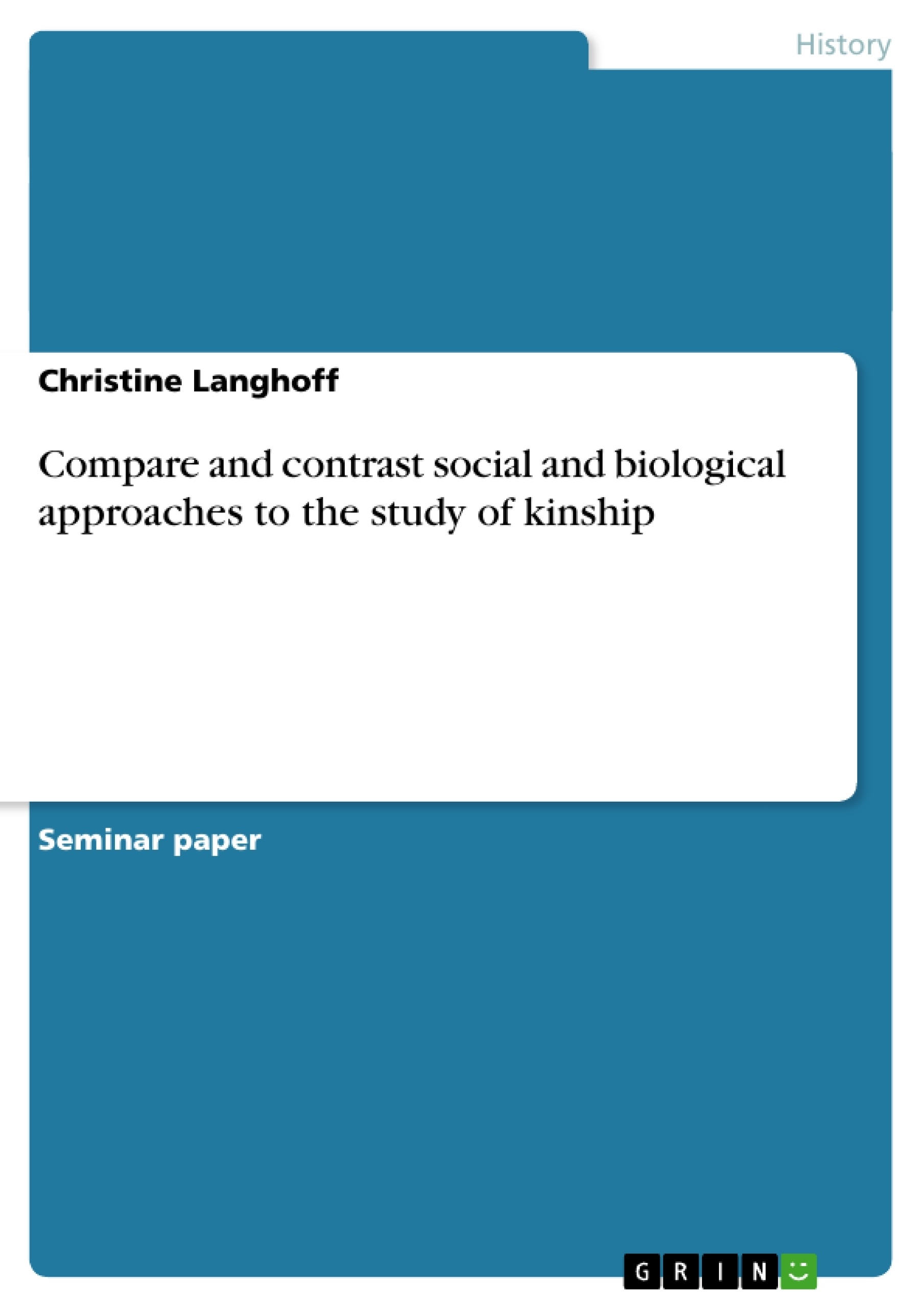Compare and contrast social and biological approaches to the study of kinship
by
Christine Langhoff
Kinship is the study of cultural interpretations of social relationships and social groups that are formed among people who stand in biological or quasi-biological relationships to each other. There are two main approaches to the study of kinship: the biological approach and the social approach. Both approaches can be further divided into different approaches. In the biological approach for example there are socio-ecological, socio-biological and evolutionary theories whereas in the social ones there are theories which try to explain overall patterns of kinship and others which state that one cannot make any generalisations about kinship patterns in different societies. Both approaches try to explain the different types of kinship structures and descent patterns but they do so in different ways. Biological theories often compare nonhuman primate kinship systems with those of humans and they also try to find evidence for the evolution of kinship structures. They tend to emphasise biological features within kinship and usually regard kinship systems as well adapted to environmental conditions. Social approaches on the other hand are more concerned about cultural differences between societies which cause the different kinds of kinship and descent structures and they emphasise non-biological relationships within kinship.
The biological approach to the study of kinship can be split into many different approaches such as socio-ecological, socio-biological as well as evolutionary approaches. Socio-ecology and socio-biology try to show that human institutions, like the structures of animal societies, are adaptive, that is to say they result from the actions of individuals attempting to maximise their inclusive fitness. This means that in the biological approaches compare human kinship patterns to those found in other animals, in particular in primates. Although they do stress the importance of biological relationships between kin they also accept that people who are not biologically related can be kin too.
[...]
Inhaltsverzeichnis
- Kinship is the Study of cultural interpretations of social relationships and social groups that are formed among people Who stand in biological or quasi-biological relationships to each other.
- There are two main approaches to the Study of kinship: the biological approach and the social approach.
- The biological approach to the Study of kinship can be split into many different approaches such as socio-ecological, socio-biological as well as evolutionary approaches.
- In comparison to the biological approaches the social approaches to kinship do not tend to compare human kinship pattems to those of nonhuman primates and they do not put a lot of emphasis on the evolution of such patterns.
- Social approaches are more concerned about the question 'Who are the legal parents of a child" as opposed to 'Who are the genetic parents of a child".
- Social approaches to kinship are more concerned With how kin relations are traced as tracing kin relations out through father and mother creates the networks of kinship fies.
- All in all it can be Said that the biological approach and the social approach are similar in some Ways as they both try to explain overall patterns of kinship, but they do so in different ways.
- Bibliography
Zielsetzung und Themenschwerpunkte
Der Text zielt darauf ab, die biologischen und sozialen Ansätze zur Erforschung von Verwandtschaft zu vergleichen und zu kontrastieren. Er untersucht die verschiedenen Theorien und Perspektiven, die innerhalb dieser beiden Ansätze vorherrschen, und beleuchtet deren Stärken und Schwächen.
- Die Bedeutung biologischer Beziehungen in Verwandtschaftssystemen
- Die Rolle von Kultur und sozialen Normen bei der Gestaltung von Verwandtschaftsbeziehungen
- Die evolutionären Ursprünge von Verwandtschaft und die Anpassung an die Umwelt
- Die Bedeutung von Erbschaftsmustern und der Organisation von Verwandtschaftsgruppen
- Die Kontroverse zwischen biologischen und sozialen Determinanten von Verwandtschaft
Zusammenfassung der Kapitel
Der Text beginnt mit einer Einführung in das Konzept der Verwandtschaft und stellt die beiden Hauptansätze, den biologischen und den sozialen Ansatz, vor. Der biologische Ansatz wird weiter in verschiedene Unteransätze unterteilt, darunter die sozio-ökologische, die sozio-biologische und die evolutionäre Perspektive. Diese Ansätze betonen die Bedeutung biologischer Beziehungen, die Anpassung an die Umwelt und die Evolution von Verwandtschaftssystemen. Sie betrachten die Verwandtschaft häufig im Vergleich zu nichtmenschlichen Primaten und versuchen, die evolutionären Wurzeln von menschlichen Verwandtschaftsstrukturen zu erklären. Der Text beleuchtet die Konzepte der Inklusiven Fitness, der Kin-Selektion und der sozio-biologischen Erklärungen für Paarungsmuster wie Monogamie und Polygamie.
Im Gegensatz dazu konzentrieren sich die sozialen Ansätze auf die kulturellen Unterschiede zwischen Gesellschaften und die Rolle von sozialen Normen bei der Gestaltung von Verwandtschaftssystemen. Sie betonen die Bedeutung von Erbschaftsmustern, der Organisation von Verwandtschaftsgruppen und den kulturellen Interpretationen von biologischen Beziehungen. Der Text diskutiert die Theorien von Schneider, Leach und anderen, die argumentieren, dass die Verwandtschaft ein kulturelles Konstrukt ist, das durch soziale Normen und symbolische Interpretationen geprägt wird. Er beleuchtet auch die Bedeutung von rechtlichen Eltern und die Unterscheidung zwischen biologischen und sozialen Eltern, insbesondere im Kontext von künstlicher Befruchtung, Adoption und Pflege. Der Text untersucht die Bedeutung von Verwandtschaftsverbindungen in verschiedenen Gesellschaften, einschließlich der Rolle von Verwandtschaftsgruppen bei wichtigen Lebensereignissen wie Geburt, Festen, Heirat und Tod.
Schlüsselwörter
Die Schlüsselwörter und Schwerpunktthemen des Textes umfassen Verwandtschaft, biologischer Ansatz, sozialer Ansatz, sozio-ökologie, sozio-biologie, Evolution, Inklusive Fitness, Kin-Selektion, Paarungsmuster, Kultur, soziale Normen, Erbschaftsmuster, Verwandtschaftsgruppen, rechtliche Eltern, biologische Eltern, soziale Eltern, Verwandtschaftsverbindungen, Stammesgesellschaften, westliche Gesellschaften, Inzesttabu.
- Quote paper
- BA (Oxon), Dip Psych (Open) Christine Langhoff (Author), 2002, Compare and contrast social and biological approaches to the study of kinship, Munich, GRIN Verlag, https://www.grin.com/document/7615
-

-

-

-
Upload your own papers! Earn money and win an iPhone X. -

-
Upload your own papers! Earn money and win an iPhone X. -

-
Upload your own papers! Earn money and win an iPhone X. -

-
Upload your own papers! Earn money and win an iPhone X. -

-
Upload your own papers! Earn money and win an iPhone X.

